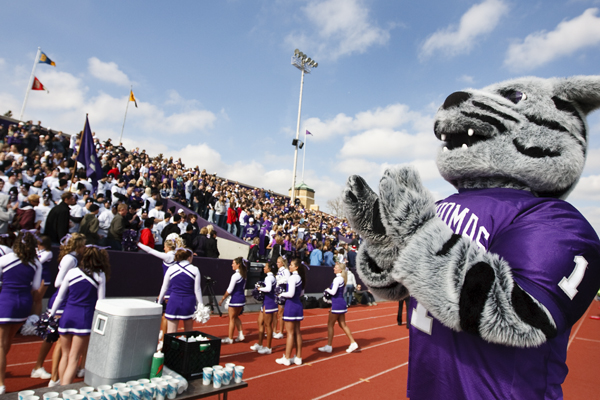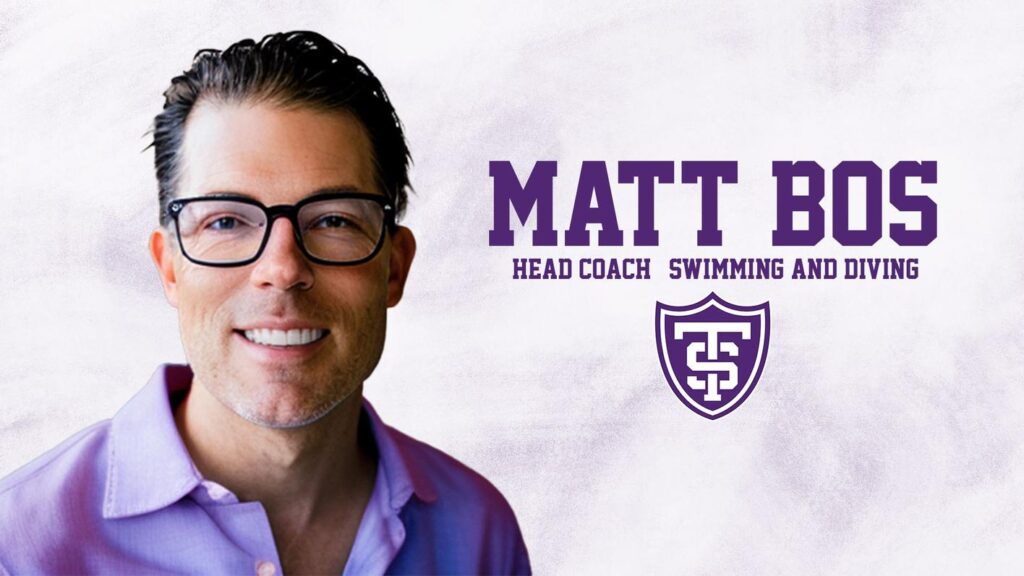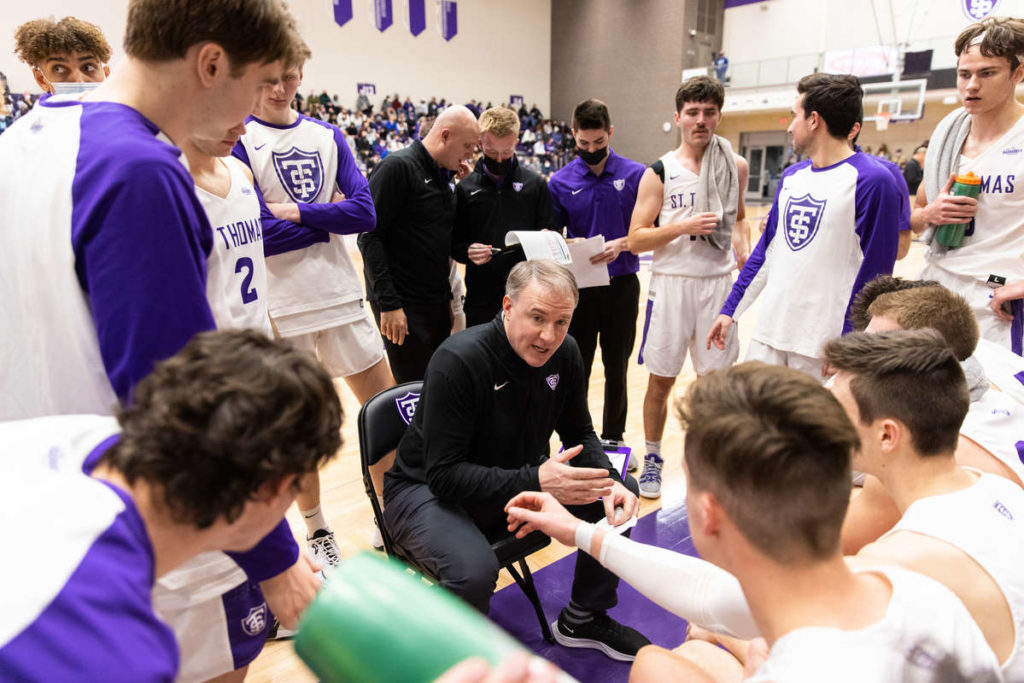Today, it’s almost impossible to imagine a home football or basketball game, homecoming parade or major campus event without the school mascot. People of all ages expect and are happy to see the permanently smiling face of the gray-and-black-striped Tommie, dishing out high-fives and pumping people up.
Tommie, however, hasn't always been so ubiquitous at major St. Thomas events. In fact, it’s only been in the last 15 years or so the feline of undetermined origin has become an official, day-to-day part of the university’s world.
“The mascot is a small part of that overall school spirit, but it’s really a symbol,” said Aaron Macke, director of residence life and the main coordinator for bringing an official mascot to St. Thomas in the early 2000s. “It’s come a long way in a pretty short period of time.”
A striped history
For more than the first 50 years after the College of St. Thomas opened its doors in 1885, there was no inkling whatsoever of a mascot participating in campus events. As St. Thomas archivist Ann Kenne points out, the first real rumblings of the idea can be found in a 1947 article in The Aquin, the student newspaper.
“Why not a mascot?” the article headlines. “Suggestions from various students have been coming this way during the past week. One was of particular interest. How are the chances of getting a mascot for the different athletic teams – a bulldog, Irish setter or some such. Dress it up in a sweater with a ‘Tommie’ or ‘ST’ on the garment and have the mascot at all football games and basketball games.”
It wasn’t until the mid-1950s, though, that a mascot first showed up on campus, and when it did it was a tiger. Tommy Tiger, to be exact. The Letterman’s Club managed and manned the suit, which was a campus staple into the 1970s before interest died away.
Several iterations of a feline Tommie appeared over the 1980s and 1990s, ranging from “cuddly cartoon character to fanged feline,” reads an October 2000 Aquin article. It wasn’t until a campus task force centered on increasing school spirit in the early 2000s that the modern mascot was born.
That was part of a full school program initiative, which included the launch of Tommie Tuesdays (encouraging students, faculty and staff to wear purple on Tuesdays), a pep team and an overall recapturing of the color purple.
“I learned a lot more about mascots than I ever thought I would,” said Macke, who consulted with the University of Minnesota’s Goldy and the Mall of America’s mascot programs as part of preparing St. Thomas.
Odd names, odd mascots
A large part of the lack of official mascot for so long was a lack of its peers across Division III athletics, including in the Minnesota Intercollegiate Athletic Conference. With long-standing chants at MIAC athletic contests featuring the likes of, “What’s a Johnnie?” or, “What’s a Gustie?” it makes sense there weren’t readily-available mascots to symbolize them.
“You look at our league, Tommies, Johnnies, Auggies, Cobbers, and there are no such things,” St. Thomas athletic director Steve Fritz said. “There’s not natural kinds of things for that when your nickname is short for your name.”
As more mascots started to pop up, though, Fritz said it became a mentality of, “They have one, so why don’t we?”
Now knowing the rallying point for school spirit a mascot can be, it’s no surprise more MIAC and Division III schools have made a point to solidify their own. As with most schools, St. Thomas’ mascot has a rotating team of student workers, whose identities are a closely kept secret. A 2008 Aquin article, “Tommie: Public job, secret students,” interviewed two Tommie mascot workers and had to change their names to “protect the secret identities of the seven Tommies.”
“Talking is a bit of a challenge because my friends will be like, ‘Is that you?’ Of course my roommate knows,” said “Joe” in the article.
“Joe,” like all the mascot’s internal personas over the years, has represented a cat in appearance, “but in spirit, Tommie represents all members of the St. Thomas community and our desire to celebrate our belonging,” reads the university’s Mascot and Escort Operations and Guidelines document. Over the past decade-and-a-half – and certainly before that official arrival – thousands of pictures of fans interacting with Tommie show that celebration occurring.
Future, current and past St. Thomas students can point to those moments of running into Tommie and knowing they were well represented in gray, black and purple.
A Rat with nine lives in Collegeville
More than 60 years ago, an unlikely Johnnie student spirit tradition began at the Warner Palaestra during basketball season on the St. John’s campus. A student spirit group donned funny red costumes to cheer on the home Johnnies and make life tough on opposing teams.
They became known as the Rats, and since their creation, life at SJU has never been exactly the same.
The Rats later became a fixture at SJU football games. While the student group’s behavior has been tamer over the last 15 years, many Rats and their unsanctioned antics in the 1970s and 1980s likely would have been assessed a whole lot of Red cards – the soccer kind.
According to school lore, SJU’s 1950s student Frank “Rat” Berres started the Rat pack. In a 2004 story in the St. John’s alumni magazine, Chris Lusvardi explained how the Rat tradition evolved. While well intentioned, the Rats’ antics occasionally crossed the line of good taste. Lusvardi noted that longtime basketball coach Jim Smith generally saw the humor and spirit, although legendary football coach John Gagliardi was no fan, and when he became athletic director in 1976, folks wondered if he might ban the group.
A campus monk, Kurt Kaiser, designed an image of the Johnnie Rat for a campus poster contest and won first place while hanging it from St. Boniface Hall. The Rat wore a red SJU jersey while holding a peace sign, in reference to the Vietnam War.
Eventually, the SJU sports information office started using the Rat on basketball programs, replacing the blue jay. In fact, the school tried to introduce a Blue Jay mascot – a play off the Johnnies’ “J” and blue secondary school color. But when a student dressed in a blue jay outfit walked onto the court, the crowd was silent, then erupted in a chant of, “Kill the bird, kill the bird!” The final score: Rats 1, Blue Jay 0.
“The Rat is the only thing that has withstood the test of time,” said Smith, who was basketball head coach in Collegeville for 51 years. “It’s an unusual mascot: a harmless little rodent.”
Lusvardi wrote that the group gradually tried to be more family friendly, even wearing clown-like costumes with wigs, thermal underwear, boxer shorts, red body paint or tights. A former Rat Packer of the 1990s said, “We’re just dummies running around in our underwear.” Another added, “It’s a good excuse to be crazy and have a lot of fun.”
Lusvardi said that the Rats became known for their creative entrances into Clemens Stadium. Their traditional entrance was through the woods and down the hill on the southeast corner. The Rats have used bikes, canoes and plastic pools, among other methods, sounding their arrival with trumpet and trombone blasts.
Since 2000, the Rat Pack has been featured locally by KARE 11 TV’s Perk-at-Play, and even made Sports Illustrated magazine’s list of the country’s “Zaniest Cheerleaders."
As one SJU alum explained, “Every Johnnie has a little bit of ‘Rat’ in him.”






